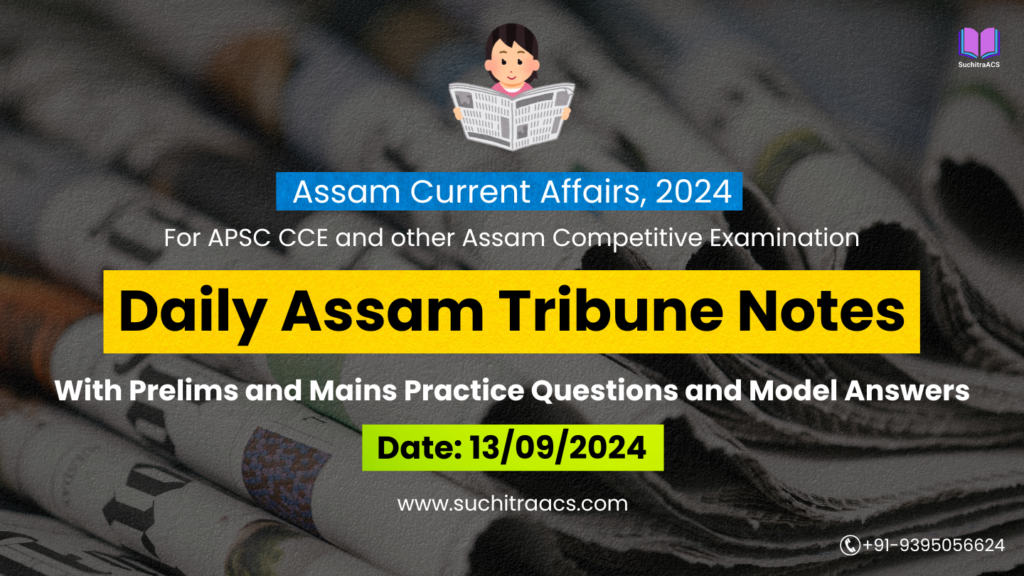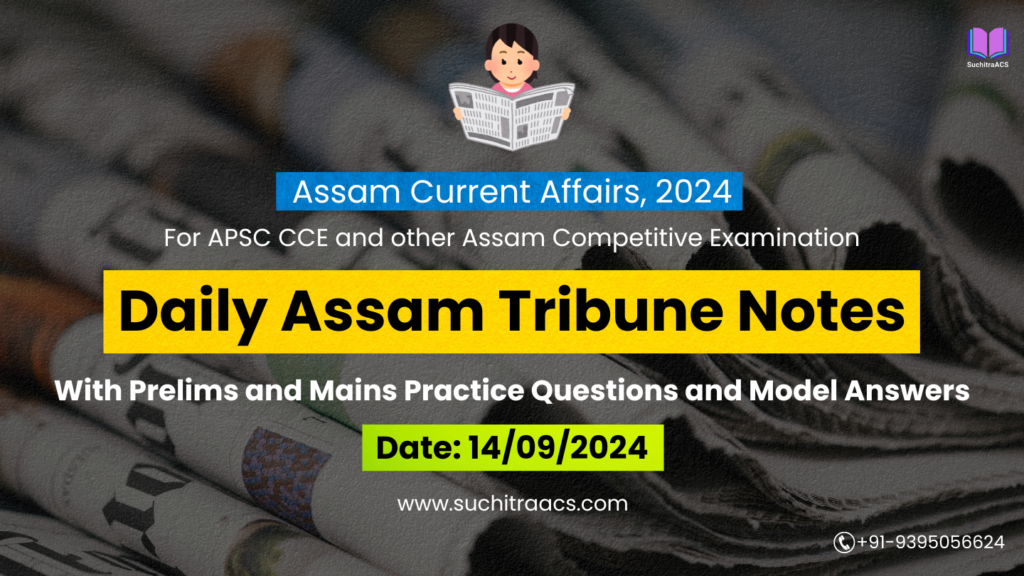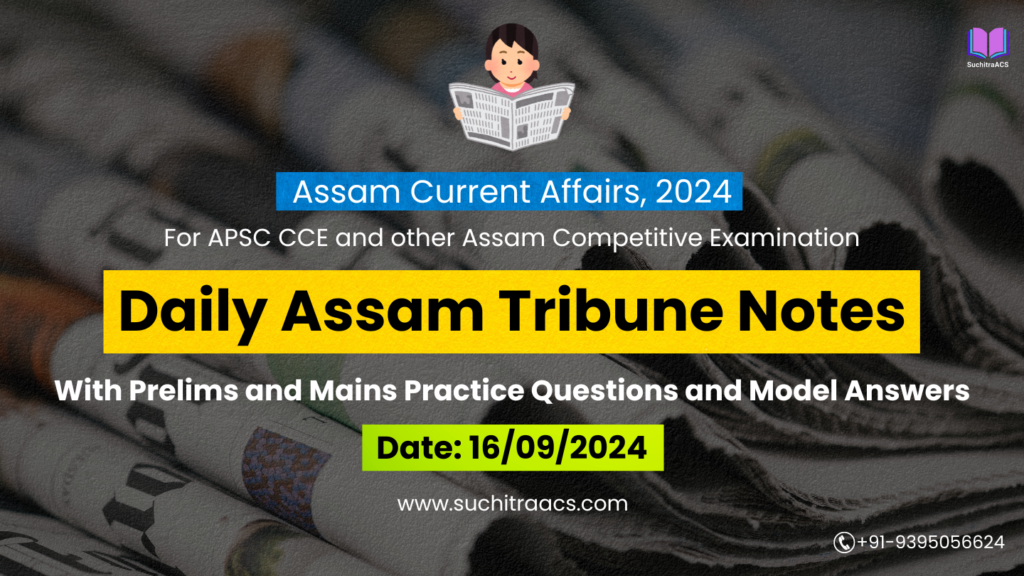APSC Current Affairs: Assam Tribune Notes with MCQs and Answer Writing (27/02/2025)
For APSC CCE and other Assam Competitive examinations aspirants, staying updated with current affairs is vital. This blog covers most important topics from the Assam Tribune today (27-02-2025). These issues are key for both APSC Prelims and Mains preparation, offering insights into the APSC CCE Syllabus.
1. Assam Secures Investments Worth ₹4.91 Lakh Crore at Advantage Assam 2.0
📌 GS Paper 3: Economy, Investment, Infrastructure Development
📌 GS Paper 2: Government Policies & Interventions
Introduction
The Advantage Assam 2.0 Summit concluded with Assam securing ₹4.91 lakh crore worth of investment proposals across sectors like infrastructure, energy, healthcare, tourism, and industry. The summit aimed at positioning Assam as an industrial hub and enhancing regional connectivity.
Key Points
1. Major Investment Highlights
✅ Infrastructure Development – ₹80,000 crore announced for new roadways, tunnels, and bridges.
✅ Healthcare Expansion – MoUs signed for multi-specialty hospitals and medical research centers.
✅ Energy & Green Hydrogen – Investments in biofuel blending, green hydrogen, and gas exploration.
✅ Modernization of Waterways – ₹4,800 crore allocated for inland waterway transport and riverine tourism.
2. Key Projects Announced
✔️ Guwahati Ring Road (₹5,800 crore) – Aimed at decongesting the city.
✔️ Brahmaputra Underwater Tunnel (₹15,000 crore) – To connect Gohpur and Numaligarh.
✔️ Kaziranga Elevated Corridor (₹6,000 crore) – Wildlife-friendly infrastructure project.
✔️ Expansion of Inland Waterways & Ports (₹4,800 crore) – Including a Water Metro for Guwahati.
3. Challenges in Implementing Investment Proposals
🚧 Need for Infrastructure Upgrades to Support Large Industries.
🚧 Balancing Industrial Growth with Environmental Sustainability.
🚧 Skilled Workforce Shortage for High-Tech Sectors.
Prelims Pointers
- Advantage Assam 2.0 – Investment summit to boost Assam’s industrial and economic landscape.
- Brahmaputra Underwater Tunnel – A 12.5 km tunnel project for better regional connectivity.
- Harit Nauka Scheme – A green vessel initiative to make Assam’s waterways eco-friendly.
Mains Pointers
How Will Advantage Assam 2.0 Impact Assam’s Economy?
✅ Diversifies the Economy Beyond Agriculture & Tea Industry.
✅ Boosts Employment & Strengthens Regional Connectivity.
✅ Encourages Foreign Direct Investment (FDI) in Northeast India.
Way Ahead
✅ Fast-Tracking Policy Implementation & Ensuring Transparent Governance.
✅ Developing Industrial Townships & SEZs for New Investors.
✅ Encouraging Public-Private Partnerships (PPPs) for Industrial Growth.
Conclusion
The Advantage Assam 2.0 Summit is a game-changer for the state’s economic transformation. With proper policy execution, infrastructure development, and sustainable growth measures, Assam is set to emerge as a major investment destination in India.
2. Assam to Roll Out ‘One District, One Product’ (ODOP) Initiative to Boost Local Economy
📌 GS Paper 3: Economy, MSMEs, Rural Development
📌 GS Paper 2: Government Schemes & Policies
Introduction
The Assam government has announced the launch of the ‘One District, One Product’ (ODOP) initiative to promote district-specific industries, local handicrafts, and agro-based products. The scheme aligns with the Atmanirbhar Bharat Abhiyan, aiming to strengthen micro, small, and medium enterprises (MSMEs) and create employment opportunities.
Key Points
1. Objectives of the ODOP Initiative
✅ Promoting Unique District-Based Industries – Each district will focus on a specialized product for economic growth.
✅ Strengthening Local Supply Chains & Market Access – Encouraging direct farmer-to-market linkages and e-commerce exports.
✅ Enhancing Skill Development & Entrepreneurship – Training artisans and farmers for quality improvement & innovation.
✅ Boosting Rural Employment & Women-Led Enterprises – Encouraging handloom, handicrafts, and organic farming businesses.
2. Key Products Identified Under ODOP in Assam
✔️ Majuli (Handloom & Masks) – Famous for traditional Assamese handloom sarees and cultural masks.
✔️ Tezpur (Tea & Organic Spices) – Special focus on premium Assam tea and organic pepper cultivation.
✔️ Barpeta (Bell Metal Craft) – Promotion of traditional brass and bell metal products.
✔️ Dhubri (Jute & Bamboo Crafts) – Expansion of eco-friendly, biodegradable handicrafts.
3. Challenges in Implementing ODOP
🚧 Lack of Modern Marketing Strategies & Branding.
🚧 Need for Infrastructure & Financial Support to MSMEs.
🚧 Ensuring Quality Standardization for Global Exports.
🚧 Limited Awareness & Training Among Local Producers.
Prelims Pointers
- One District, One Product (ODOP) – Aims to promote district-specific industries across India.
- MUDRA Scheme – Provides collateral-free loans to MSMEs & small entrepreneurs.
- Geographical Indication (GI) Tags in Assam – Includes Muga Silk, Assam Tea, and Boka Chaul (Sticky Rice).
Mains Pointers
How Will ODOP Benefit Assam’s Economy?
✅ Encourages Rural Industrialization & Self-Employment.
✅ Boosts Export Potential of Assam’s Traditional Products.
✅ Reduces Dependence on Agriculture by Expanding Local Manufacturing.
Way Ahead
✅ Strengthening Digital Market Access & E-Commerce Exports.
✅ Providing Financial & Technical Assistance to Artisans & Farmers.
✅ Establishing District-Level Processing & Packaging Units for ODOP Products.
Conclusion
The ODOP initiative in Assam can transform district economies by promoting their unique heritage and industries. With strong policy implementation, market expansion, and skill development, Assam can emerge as a key player in India’s MSME sector.
3. Assam to Implement ‘Project Jal Jeevan’ to Provide Safe Drinking Water to Rural Households
📌 GS Paper 2: Governance, Health, Rural Development
📌 GS Paper 3: Infrastructure, Water Resource Management
Introduction
The Assam government has announced the implementation of ‘Project Jal Jeevan’, aligning with the Jal Jeevan Mission (JJM) to provide safe and piped drinking water to every rural household. The initiative aims to tackle water scarcity, improve public health, and reduce waterborne diseases in Assam’s flood-prone and drought-affected regions.
Key Points
1. Objectives of Project Jal Jeevan
✅ Ensuring Safe & Sustainable Drinking Water Supply – Providing functional tap water connections to all households.
✅ Reducing Waterborne Diseases & Improving Public Health – Controlling contamination-related illnesses like diarrhea and cholera.
✅ Strengthening Water Resource Management in Assam – Utilizing rainwater harvesting, groundwater recharge, and water conservation techniques.
✅ Women’s Empowerment & Household Convenience – Reducing the burden on women who travel long distances to fetch water.
2. Key Features of the Project
✔️ ₹8,500 Crore Investment in Rural Water Infrastructure.
✔️ Installation of Community Water Purification Plants in Arsenic-Affected Regions.
✔️ Integration of IoT-Based Smart Water Monitoring Systems.
✔️ Training Rural Youth as ‘Jal Mitras’ for Water Quality Management.
3. Challenges in Implementing Rural Water Supply in Assam
🚧 Contamination from Arsenic & Fluoride in Groundwater.
🚧 Flooding & Riverbank Erosion Impacting Water Supply Infrastructure.
🚧 Operation & Maintenance of Rural Water Supply Systems.
🚧 Need for Behavioral Change & Community Participation.
Prelims Pointers
- Jal Jeevan Mission (JJM) – A national program to provide tap water to all rural households by 2024.
- National Water Policy (2012) – Focuses on integrated water resource management.
- Atal Bhujal Yojana – A groundwater management scheme in water-scarce regions.
Mains Pointers
Why is Rural Water Supply Critical for Assam?
✅ Improves Public Health & Reduces Disease Burden.
✅ Enhances Agricultural & Livestock Sustainability in Villages.
✅ Ensures Climate Resilience in Flood & Drought-Prone Areas.
Way Ahead
✅ Expanding Water Conservation & Rainwater Harvesting Techniques.
✅ Strengthening Local Governance & Community Engagement in Water Management.
✅ Leveraging Technology for Smart Water Quality Monitoring & Leak Detection.
Conclusion
Project Jal Jeevan is a transformative initiative for Assam’s rural water security, ensuring safe drinking water, better public health, and community development. By addressing infrastructure gaps, contamination risks, and climate challenges, the state can achieve universal drinking water access in the coming years.
4. Assam to Set Up AI-Powered Smart Traffic Management System in Guwahati
📌 GS Paper 3: Science & Technology, Urban Development, Infrastructure
📌 GS Paper 2: Governance, Smart Cities Mission
Introduction
The Assam government has announced the launch of an AI-powered Smart Traffic Management System (STMS) in Guwahati, aiming to reduce congestion, improve road safety, and enhance traffic law enforcement. This initiative aligns with the Smart Cities Mission and uses Artificial Intelligence (AI), Internet of Things (IoT), and real-time data analytics to manage urban traffic efficiently.
Key Points
1. Objectives of the Smart Traffic Management System
✅ Reducing Traffic Congestion & Improving Mobility – AI-driven adaptive traffic signals to ease flow.
✅ Enhancing Road Safety & Reducing Accidents – AI-based surveillance to detect violations like over-speeding and red-light jumping.
✅ Integrating Public Transport & Smart Parking – Digital platforms for real-time tracking of buses and parking availability.
✅ Minimizing Pollution from Traffic Congestion – Lower fuel consumption due to optimized traffic flow.
2. Key Features of AI-Powered Traffic System
✔️ AI-Enabled Traffic Signals for Adaptive Flow Management.
✔️ High-Resolution CCTV & ANPR (Automatic Number Plate Recognition) Cameras for violation detection.
✔️ Integrated Mobile App for Citizens – Real-time traffic updates, route planning, and complaint registration.
✔️ E-Challan System for Automated Traffic Fine Collection.
3. Challenges in Implementing Smart Traffic Management in Assam
🚧 High Cost of AI-Based Traffic Systems.
🚧 Need for Stronger Cybersecurity Measures Against Data Theft.
🚧 Public Awareness & Compliance with New Traffic Regulations.
🚧 Infrastructure Gaps & Slow Adoption of Smart Transport Solutions.
Prelims Pointers
- Smart Cities Mission (2015) – Urban transformation program to improve infrastructure & technology-driven governance.
- National Intelligent Transport System (ITS) – Aims at digitizing and optimizing urban mobility solutions.
- ANPR (Automatic Number Plate Recognition) – Uses AI to detect vehicles violating traffic laws.
- E-Challan System – Digital penalty system for automated traffic fine collection.
Mains Pointers
How Will Smart Traffic Management Improve Urban Mobility in Assam?
✅ Reduces Commuting Time & Fuel Wastage.
✅ Ensures Better Law Enforcement & Road Safety Compliance.
✅ Integrates AI & IoT for Efficient Public Transport Management.
Way Ahead
✅ Expanding AI-Based Traffic Systems to Other Cities Like Dibrugarh & Silchar.
✅ Encouraging Public Awareness Campaigns for Road Discipline & Safe Driving.
✅ Collaborating with Private Firms for AI & Data Analytics Integration.
Conclusion The AI-powered Smart Traffic Management System in Guwahati is a crucial step towards modern urban mobility solutions. With proper implementation, technological integration, and public cooperation, Assam can emerge as a model state for smart city infrastructure in Northeast India.
APSC Prelims Practice Questions
1. Assam Secures Investments Worth ₹4.91 Lakh Crore at Advantage Assam 2.0
Question 1
Which of the following sectors received major investment commitments at Advantage Assam 2.0?
- Infrastructure and connectivity
- Green energy and hydrogen fuel
- Healthcare and medical research
- River tourism and waterways
Select the correct answer using the codes below:
(a) 1 and 2 only
(b) 1, 2, and 3 only
(c) 2, 3, and 4 only
(d) 1, 2, 3, and 4
✅ Answer: (d) 1, 2, 3, and 4
🔎 Explanation:
- All four sectors received investment commitments at the Advantage Assam 2.0 Summit.
- The summit aims to modernize infrastructure, promote clean energy, enhance healthcare services, and develop Assam’s water-based tourism sector.
2. Assam to Roll Out ‘One District, One Product’ (ODOP) Initiative
Question 2
Which of the following are major products identified under Assam’s One District, One Product (ODOP) initiative?
- Muga Silk in Majuli
- Tea and Organic Spices in Tezpur
- Bell Metal Craft in Barpeta
- Sandalwood Production in Karbi Anglong
Select the correct answer using the codes below:
(a) 1 and 2 only
(b) 1, 2, and 3 only
(c) 2, 3, and 4 only
(d) 1, 2, 3, and 4
✅ Answer: (b) 1, 2, and 3 only
🔎 Explanation:
- Muga Silk (Majuli), Tea & Organic Spices (Tezpur), and Bell Metal Craft (Barpeta) are included under ODOP.
- Sandalwood Production in Karbi Anglong is incorrect, as the district is more known for its bamboo and forest-based industries.
3. Assam to Implement ‘Project Jal Jeevan’ for Rural Drinking Water
Question 3
Which of the following schemes is directly linked to Assam’s ‘Project Jal Jeevan’?
(a) Namami Gange Programme
(b) Jal Jeevan Mission
(c) Pradhan Mantri Krishi Sinchayee Yojana (PMKSY)
(d) National Rural Health Mission
✅ Answer: (b) Jal Jeevan Mission
🔎 Explanation:
- Jal Jeevan Mission (JJM) aims to provide safe and piped drinking water to all rural households in India by 2024.
- The Namami Gange Programme is focused on cleaning the Ganga river and does not cover drinking water supply in Assam.
Question 4
Which of the following factors pose challenges to rural drinking water supply in Assam?
- Arsenic and fluoride contamination in groundwater
- Flooding and riverbank erosion
- Limited community participation in water management
- High salinity in drinking water sources
Select the correct answer using the codes below:
(a) 1 and 2 only
(b) 1, 2, and 3 only
(c) 2, 3, and 4 only
(d) 1, 2, 3, and 4
✅ Answer: (b) 1, 2, and 3 only
🔎 Explanation:
- Arsenic and fluoride contamination, floods, and low community participation are major challenges in Assam’s rural water supply.
- High salinity (statement 4) is not a major issue in Assam, as it is more common in coastal regions.
4. Assam to Set Up AI-Powered Smart Traffic Management System in Guwahati
Question 5
Which of the following technologies are part of Assam’s AI-powered Smart Traffic Management System (STMS)?
- AI-enabled adaptive traffic signals
- Automatic Number Plate Recognition (ANPR) cameras
- Real-time public transport tracking
- Blockchain-based e-challan payments
Select the correct answer using the codes below:
(a) 1 and 2 only
(b) 1, 2, and 3 only
(c) 2, 3, and 4 only
(d) 1, 2, 3, and 4
✅ Answer: (b) 1, 2, and 3 only
🔎 Explanation:
- Smart Traffic Management Systems include AI-driven traffic signals, ANPR cameras, and public transport tracking.
- Blockchain-based e-challan payments are not yet implemented in Assam but may be considered in the future.
Question 6
Which of the following government programs focus on improving urban traffic and mobility in India?
- Smart Cities Mission
- National Urban Transport Policy
- Bharatmala Project
- FAME India Scheme
Select the correct answer using the codes below:
(a) 1 and 2 only
(b) 1, 2, and 3 only
(c) 2, 3, and 4 only
(d) 1, 2, 3, and 4
✅ Answer: (d) 1, 2, 3, and 4
🔎 Explanation:
- Smart Cities Mission focuses on technology-driven urban development.
- National Urban Transport Policy promotes sustainable urban mobility.
- Bharatmala Project aims at improving national highways and road networks.
FAME India Scheme (Faster Adoption of Electric Vehicles) supports electric mobility in urban transport.
APSC Mains Practice Question
Q. Assam’s Advantage Assam 2.0 Summit has attracted significant investment commitments across various sectors. Critically analyze the potential benefits and challenges of these large-scale investments in transforming Assam’s economic landscape. Suggest measures to ensure sustainable industrial growth in the state.” (250 words, 15 marks)
Model Answer
Introduction
The Advantage Assam 2.0 Summit has secured ₹4.91 lakh crore worth of investments in sectors like infrastructure, energy, healthcare, and tourism. These investments aim to boost Assam’s economy, generate employment, and strengthen regional connectivity. However, challenges related to infrastructure, environmental concerns, and policy execution must be addressed for sustainable industrial growth.
Potential Benefits of Large-Scale Investments in Assam
✅ Economic Diversification & Industrial Growth
- Moves Assam beyond agriculture and tea-based economy.
- Strengthens manufacturing, logistics, and energy sectors.
✅ Employment Generation & Skill Development
- Creation of direct and indirect jobs across various industries.
- Upskilling local youth through industrial training programs.
✅ Infrastructure Development & Regional Connectivity
- Projects like Brahmaputra Underwater Tunnel & Guwahati Ring Road to improve transport and logistics.
- Enhances trade under Act East Policy with ASEAN nations.
✅ Renewable Energy & Sustainable Industrialization
- Focus on green hydrogen, biofuel, and hydropower projects.
- Reduces carbon footprint and energy dependence.
Challenges in Implementing Large-Scale Investments
🚧 Land Acquisition & Bureaucratic Delays – Slow project clearances hinder industrial expansion.
🚧 Environmental Concerns & Ecological Impact – Projects like Kaziranga Elevated Corridor must balance development with conservation.
🚧 Limited Skilled Workforce for High-Tech Industries – Need for training in AI, automation, and renewable energy sectors.
🚧 Connectivity & Logistics Barriers – Remote areas still lack rail, air, and digital infrastructure.
Measures for Sustainable Industrial Growth
✅ Fast-Tracking Policy Implementation & Governance Reforms – Streamline bureaucratic processes for ease of doing business.
✅ Public-Private Partnerships (PPPs) in Infrastructure Development – Encourage private sector participation in energy & manufacturing.
✅ Environmental Impact Assessments & Sustainable Development Plans – Ensure eco-friendly industrialization.
✅ Skill Development & Local Employment Initiatives – Set up training centers for future-ready jobs.
Conclusion
The Advantage Assam 2.0 Summit marks a transformative phase for Assam’s economy. However, to maximize its impact, the state must focus on infrastructure upgrades, policy efficiency, environmental safeguards, and workforce readiness. With a balanced approach, Assam can emerge as a leading industrial hub in Northeast India while ensuring sustainable economic growth.
✨ APSC Prelims Crash Course, 2025
at most affordable rate in Assam!

🔔 Join Our WhatsApp Study Group!
For exclusive access to premium quality content, including study materials, current affairs, MCQs, and model answers for APSC CCE and other Assam competitive exams.
Click here to join: SuchitraACS Study WhatsApp Group
📚 Want to know more about SuchitraACS’s most affordable courses?
Click here to know more: SuchitraACS Courses for APSC CCE and Assam Competitive Examinations




